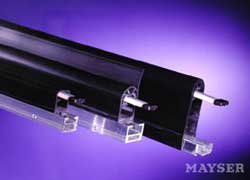
Posted to News on 17th Jul 2007, 22:19
Tactile safety devices explained
Barry Goodwin of Leuze Mayser describes the various types of tactile safety devices that are available for machinery applications, namely safety mats, bumpers and edges.

It will come as no surprise that, as we go about our lives, we all experience the benefits of tactile safety without noticing it - the lift door, bus and train doors, revolving doors – all could have tactile contact technology embedded in a safe edge, stopping us from becoming trapped or dragged. It puts safety right at the point of danger.
When we enter the field of industrial safety, the same principle applies, but in this case the safe edge and associated control are developed to a higher standard, as severe injury, or even a fatality, may result if personnel are not protected from the hazards of dangerous machinery.
Probably the most widely used and proven concept for tactile safety is the safe edge, which comprises a tough resilient rubber profile housing and a switching sensor; when external pressure is applied to the profile the sensor is tripped, initiating a stop signal.
The very latest designs in this style utilise a combination of highly sensitive mechanical/electronic technology within a profile, allowing even small fingers or clothing caught in the closing edge to be detected.
While the principle has remained unchanged for many years, companies like Leuze Mayser have extended the functionality with the introduction of an ASi Bus capability. It has enabled Leuze Mayser to integrate tactile safety onto a bus system with a series of other individual safety devices to one safety module, allowing the simple addition or removal of devices within the fieldbus circuit. The Asi safety bus [ASi Safety at Work, or AsiSafe] allows many individual devices such as safe edges, emergency stop switches, safety interlocking devices, safety light curtains, grids and safety scanners to all be supported on a single cable without jeopardising safety integrity; the system also allows non-safety devices to be connected on the same network.
The versatility and diversity of tactile safety systems has allowed the creation of pressure-sensitive safety mats, and a much more versatile device in the form of a safety bumper that can be shaped to suit a particular application; however, the most widely used tactile safety device is believed to be the safe edge.
Mats
These are basically a pressure-sensitive mat system that can be shaped to suit most requirements and is suitable for placement in front of CNC punch machines, around robot stations, transfer lines, loading ramps, etc, offering up to a safety category 3 (EN 954-1) protection for hazardous areas. Mayser safety mats are offered with various anti-slip rubber toppings to suit various applications, and come with a range of aluminium ramp edgings and fixings to avoid the danger of tripping.
Bumpers
Safety bumpers feature a large impact cushion made of soft foam with a suitable skin and incorporating a switching element. The soft foam construction prevents injuries to personnel and damage to property until a safe standstill is achieved. Indentation of the foam profile causes the switching element to activate, calling a halt to further movement of the devices – which might be die carts, AGVs, shuttle cars, etc.
Safety edges
From lift platforms to machine doors, and from sliding shelves to rollout gates, these are commonly used. Slight pressure is sufficient to avert injury, with the closed-circuit principle reliably protecting personnel from potentially dangerous automatic movements. They are manufactured to any length and can be further customised to include angles, with or without dead zones, etc.
A non-safety version of safe edges can be found in county courts and police interview rooms; placed around the wall like a dado rail, they provide a simple 'push anywhere to actuate' alarm.
Sticking with the contact-style safe edges, miniature versions have evolved, expanding their applications into the automobile industry to prevent human body parts being trapped during closure of electronic windows. The furniture industry, with its rise and recline chairs, adjustable powered tables and other powered aids for the disabled, also use miniaturised safe edges.
Optical safe edges
A recent innovation has been optical safety edges, whereby deformation of the rubber profile interrupts an optical beam, initiating a stop signal. As a new development, some observers feel the operating concept does not have a strong proven track recorded and must be viewed with caution, although in the long-term it will probably offer a viable alternative to contact switches and may open new areas of application.
Want the latest machine building news straight to your inbox? Become a MachineBuilding member for free today >>
1B Fenice Court
Phoenix Park
Eaton Socon
PE19 8EW
UNITED KINGDOM
+44 (0)1480 408500

















